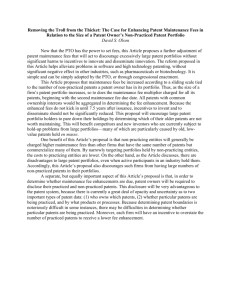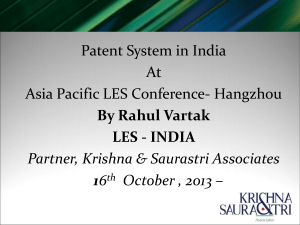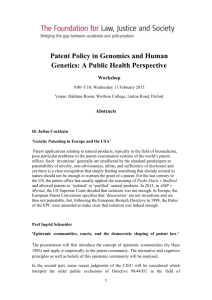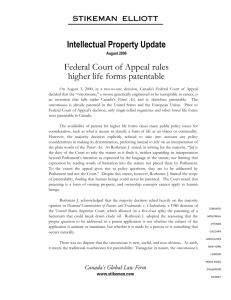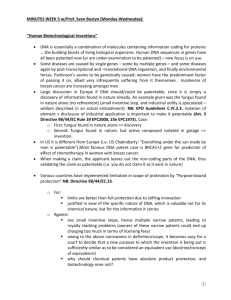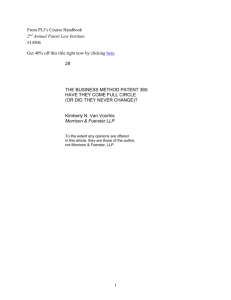CAFC and Obviousness
advertisement
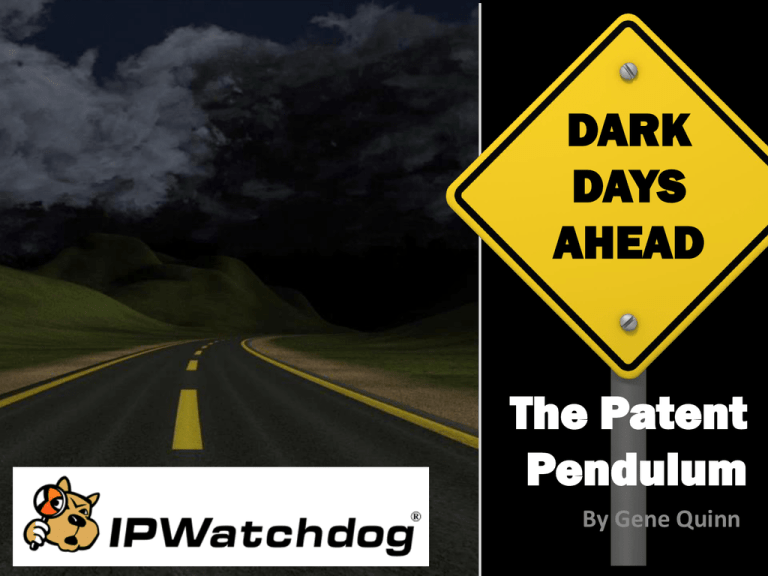
DARK DAYS AHEAD The Patent Pendulum By Gene Quinn An Ambitious Agenda Phase 1 A Brief History of the Problem Phase 2 Recent SCOTUS Decisions Phase 3 CAFC on Obviousness Phase 4 The End: Q & A Phase 1 A Brief History of the Problem For a very long time there has been a believe that innovation simply happens. Some innovations, even if new/useful, don’t deserve to be patented. Whenever a patent is granted something has been taken from the public domain. This view traces all the way back to SCOTUS flash of creative genius test. Today the problem is ignorance, misinformation and propaganda. Flash of Creative Genius Cuno Engineering Corp. v. Automatic Devices Corp., 314 U.S. 84 (1941) Since Hotchkiss v. Greenwood, decided in 1851, it has been recognized that, if an improvement is to obtain the privileged position of a patent, more ingenuity must be involved than the work of a mechanic skilled in the art... That is to say, the new device, however useful it may be, must reveal the flash of creative genius, not merely the skill of the calling. If it fails, it has not established its right to a private grant on the public domain. Anti-patent Ignorance Twitter founded in 3/2006 Filed patent application to cover “tweeting” in 7/2008 As of 9/30/2013 has 9 U.S. patents and 95 patent applications Twitter went public in 11/2013 Acquired 900 patents from IBM in 12/2013 SEC filings: constantly explain patents are “important” and other companies have MANY more patents, which presents significant risk moving forward. Modern Tech Industry Doesn’t Exist Without Patents Software has been patented since 1965. The tech industry is VERY different today than before software patents, which should be self-evident. It is also VERY different compared to when software patents started to first become more commonplace in the early 1980s. Apple, Facebook, Twitter, Google, Priceline and SO many other companies have been built on software patents. Do we only want trivial? Plugins that don’t work, or software created and then not updated, or Apps that do trivial things may not need patents, but they are never patented anyway. Software Programming Taken from Fairy Tales and Other Irrational Beliefs About Patents Published on IPWatchdog.com September 26, 2014. “It can take many years and many hundreds of team members to create a software package akin to something you might see from IBM or even a new Apple operating system. These things are not coded by a second year engineering student, and they are not trivial. It is amazing to me that anyone things creating software is trivial given how infrequently software works, how often it needs to be updated and patched, and all of the security vulnerabilities and identity theft issues that even the largest retailers face on an increasing basis.” http://www.ipwatchdog.com/2014/09/26/fairy-tales-and-other-irrational-beliefs-about-patents/id=51360/ Phase 2 SCOTUS Mayo v. Prometheus 566 U.S. ____ (2012) http://www.supremecourt.gov/opinions/11pdf/10-1150.pdf SCOTUS proclaimed that they “decline the Government’s invitation to substitute §§102, 103, and 112 inquiries for the better established inquiry under §101.” First, it is not an invitation to use 102 and 103 for novelty and non-obviousness; it is absolutely required by Title 35. Second, 101 is not the “better established inquiry” because in the 200 years leading up to Mayo v. Prometheus it had NEVER been used by any court to find a patent claim invalid because it lacked novelty, which is exactly what the Supreme Court did when it acknowledged that the claims did not cover a law of nature but rather only added conventional steps. AMP v. Myriad Genetics U.S. Supreme Court, June 13, 2013 http://www.supremecourt.gov/opinions/12pdf/12-398_1b7d.pdf “cDNA is not a product of nature and is patent eligible under §101, except insofar as very short series of DNA may have no intervening introns to remove when creating cDNA. In that situation, a short strand of cDNA may be indistinguishable from natural DNA.” “Nor are Myriad’s claims saved by the fact that isolating DNA from the human genome severs chemical bonds and thereby creates a nonnaturally occurring molecule.” But Chakrabarty said: “[R]espondent’s micro-organism plainly qualifies as patentable subject matter. His claim is not to a hitherto unknown natural phenomenon, but to a nonnaturally occurring manufacture or composition of matter – a product of human ingenuity…” Alice v. CLS Bank Decided June 2014 http://www.supremecourt.gov/opinions/13pdf/13-298_7lh8.pdf Used what they called the Mayo framework, which is ironic given how the Court so famously misapplied patent law in the Mayo case. First, determine whether the claims at issue are directed to one of those patent-ineligible concepts. Second, examine claim elements to determine whether it contains an inventive concept sufficient to transform the claimed abstract idea into a patent-eligible application. “The relevant question is whether the claims here do more than simply instruct the practitioner to implement the abstract idea of intermediated settlement on a generic computer. They do not.” “The method claims recite the abstract idea implemented on a generic computer; the system claims recite a handful of generic computer components configured to implement the same idea.” Bilski v. Kappos 561 U.S. ____ (2010) http://www.supremecourt.gov/opinions/09pdf/08-964.pdf The machine-or-transformation test is not the sole test for patent eligibility. Federal Circuit erred when it ruled that MOT was the singular test to determine whether an invention is patentable subject matter. 101 does not categorically preclude business method patents. The categorical exclusion argument was undermined by the fact that federal law – 35 USC §273(b)(1) – explicitly contemplates the existence of at least some business method patents: Under §273(b)(1), if a patentholder claims infringement based on a method in a patent, the alleged infringer can assert a defense of prior use. All 9 agreed Bilski application was properly rejected. Majority: it was properly rejected because it was an abstract idea. Concurrence: wanted to say business methods are not patent eligible unless tied to an otherwise patentable invention (see Stevens footnote 40). Consequences U.S. no longer has favorable patent laws for biotech, medical diagnostics and software. Companies will move to more favorable jurisdictions (see tax inversion). Expect far fewer medical devices (see Medtronic brief in Bilski), far more copying, only crawling incremental innovation. Portfolios substantially devalued will eventually mean shareholder value will be compromised. Wall Street will figure out that tech companies have no useful exclusive rights. Market for selling and licensing is drying up fast. Why both patent? Trade secret the new norm, which harms public. Investors reluctant to invest; not good for job creation. Phase 3 CAFC and Obviousness The Next Battleground for Patent Owners Phase 4 The End ~ Q&A Gene Quinn Patent Attorney Founder of IPWatchdog.com Email: gquinn@IPWatchdog.com Phone: 703-740-9835

